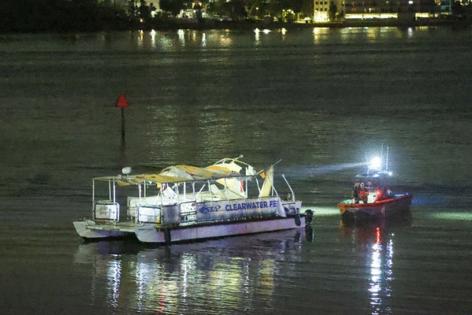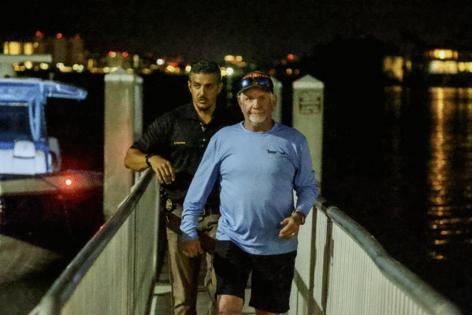Here's how the Clearwater Ferry investigation may play out
Published in News & Features
TAMPA, Fla. — As chaotic, violent and arbitrary as Sunday night’s Clearwater Ferry crash was, it also seemed like an obvious crime scene.
Onlookers watched as the boat that slammed into the ferry drove away. Police later found the boat and its driver nearly 4 miles away. Retrieved footage soon revealed the seconds leading up to the crash — that boat driving a clear path directly into the ferry.
One person, Jose Castro, 41, was killed, and 10 others were injured. Castro’s family is demanding justice.
And yet, despite the abundance of eyewitnesses and footage, it’s unclear how the criminal investigation will proceed or whom, if anyone, it will target.
The online outcry only grows: Why hasn’t an arrest been made? How long will an investigation take? Will charges be filed?
Law enforcement officials have not arrested or cited local businessperson Jeff Knight, the boater who says he was driving when he hit the ferry.
Knight’s lawyer says he left after first responders arrived because the boat he was operating was taking on water, and he worried it would sink. The lawyer also suggested the crash occurred because the ferry was not properly lit and its crew had been distracted by dolphins.
Complicating the case is where it took place: on water. Investigations into maritime crashes are often complex and take time, usually far longer than highway collisions.
So what comes next? And who, if anyone, could be held responsible?
How does a boat investigation unfold?
Amid the bedlam of a crash, law enforcement must first address the safety of everyone involved, said Florida Fish and Wildlife Conservation Commission Capt. Matthew Dallarosa.
Only after the waters calm and everyone is accounted for can officials retrace events.
It’s difficult, because evidence can float away.
“Vessel accident investigations are very different than vehicle accident investigations,” Dallarosa said during a news conference Monday. “Tides and winds shift everything around.”
Wildlife officials typically use lidar, a technology that creates high-resolution models, to map damage and piece together the scene, Dallarosa said.
In this instance, Dallarosa said investigators also must consider the size and weight of each boat to determine how the collision played out.
The boats themselves present a challenge. Unlike cars that are largely made of steel, aluminum and plastic, boats are often made of fiberglass, which can bend and be more resilient in crashes, leaving fewer clues.
Alan S. Richard, a former captain for the wildlife commission and maritime law adjunct professor at Florida State University, said he’s seen investigations take as long as a year.
“It depends entirely on the accident,” Richard said. “How many people witnessed it? How many people need to be interviewed?”
The boat operator left the scene. Was that a crime?
City footage of the crash shows the recreational boat plowing into the back of the ferry, overtaking about two-thirds of the vessel.
The Coast Guard captured the chilling distress call, first reported at 8:43 p.m.
“Mayday, mayday, mayday. There’s been a boat collision. The Clearwater Ferry, uh, underneath the Clearwater Memorial Causeway. The Clearwater Ferry is adrift.”
For about 10 minutes, Knight stayed at the scene. Law enforcement found Knight and his boat about 3½ miles away.
Wildlife officials said Monday they were working with the Pinellas-Pasco State Attorney’s Office to determine whether Knight had committed a hit-and-run. Under Florida law, leaving the scene of a boat crash involving death is considered a third-degree felony punishable by up to five years in prison. Leaving the scene of a car crash involving death is considered a first-degree felony, punishable by up to 30 years in prison.
“We’re committed, if a hit-and-run occurred here, and people were injured ... we’re committed to working those charges all the way through,” Dallarosa said.
On Tuesday, Knight’s lawyer, J. Kevin Hayslett, wrote a letter to wildlife officials, disputing the notion that Knight had committed a hit-and-run.
Hayslett’s letter states that immediately after the crash, Knight directed a passenger on his boat to call 911, and that person remained on the line for nearly 12 minutes.
He also tied his vessel to the ferry to stabilize it and render aid. However, Knight noticed his boat taking on water, and the mother of an 8-week-old on board pleaded for “immediate transport,” leading Knight to motor to shore, the letter states.
In a second letter addressed to investigators Thursday, Hayslett reiterated that Knight directed passengers on his boat to call for help. The letter included sworn statements from some of Knight’s passengers.
In one letter, a passenger described hearing Knight yelling, “They had no lights, where the f— were their lights!”
Michelle Suskauer, a Palm Beach defense attorney and former Florida Bar president, said it’s important not to jump to conclusions in this type of case.
“If his boat and his occupants were in danger, that certainly is something that needs to be taken into consideration, because you don’t want to increase the tragedy here,” Suskauer said.
Michael Karcher, a Miami-based maritime lawyer and University of Miami adjunct professor, pointed to Florida law, which requires a boat’s operator, “so far as he or she can do without serious danger” to their own boat, crew and passengers, to help others affected. They also must notify law enforcement.
Karcher said it will be up to law enforcement to determine whether the crash is considered a hit-and-run.
The Pinellas-Pasco State Attorney’s Office will have the final say in whether it will bring charges. The State Attorney’s Office has previously declined to comment on the case.
Was alcohol a factor?
Law enforcement has not said what factors may have contributed to the crash.
However, speculation online has swirled, particularly as Knight’s previous history has surfaced.
One major question has arisen: his sobriety.
Knight has a history of run-ins with the law. He has been arrested three times on charges of driving while impaired, records show. He pleaded no contest each time and received probation and fines.
In 2012, Knight was on his yacht, Pure Knight Life, in the waters off the Renaissance Vinoy Resort with a group of friends after a night of partying, police said, when one of them fell off the boat. The man hit his head on the way down and drowned. The Medical Examiner’s Office found the man had alcohol and cocaine in his system.
According to wildlife officials, Knight cooperated with law enforcement after the ferry crash and consented to a Breathalyzer. He blew a 0.0, officials said.
However, Knight did not take a blood test, wildlife officials said. A blood test would show if he’d had drugs in his system.
Asked if Knight declined to take a test, officials would only say that they intend to provide an update soon.
Florida law requires that for law enforcement to force someone to provide a blood sample, they first have to observe certain attributes, like stumbling, bloodshot eyes or slurred speech.
This gives them what’s known as “probable cause” to forcefully take a blood sample.
Richard said such a test requires a search warrant signed by a judge, unless there’s no possibility of getting one before a person sobers up.
When asked by the Times about the significance of officials asking Knight to voluntarily take a Breathalyzer test, Suskauer agreed that this likely meant officials didn’t have probable cause to draw blood.
“If he blew over the legal limit, there most likely would have been an arrest immediately for boating under the influence ... but because he didn’t, regardless of whether he did or not, there needs to be a thorough investigation,” Suskauer said.
Rules and laws of the water
Karcher said certain rules on the water are expected of boaters, even without red lights or stop signs.
“They have their own rules of the road in terms of boats approaching each other, passing each other, what direction they’re coming from,” Karcher said. “It’s not just a free-for-all out there.”
This week, Rodney Barreto was reconfirmed as the chairperson of the Florida Fish and Wildlife Conservation Commission, despite public opposition stemming partly from how the agency handled a Biscayne Bay boat crash that killed 17-year-old Luciana Fernandez.
The Miami Herald reported on flaws in the investigation, which led officials to reevaluate their initial misdemeanor charges against the boat driver and charge him with felony vessel homicide.
Legislation dubbed Lucy’s Law would increase penalties for certain boating violations, including leaving the scene of a crash involving a death. The legislation would increase the penalty for leaving after someone died to a first-degree felony, which carries up to 30 years in prison.
The bill was passed by the Florida House and Senate and awaits approval from the governor, according to reporting from CBS News Miami.
Richard, the former wildlife investigator, said it’s too early to speculate if charges will be brought in this case.
However, he described a series of scenarios law enforcement and attorneys must consider if they were to do so.
Under Florida law, if someone operating a boat is found to have violated navigation rules ― a set of more than 30 created by the federal government, but adopted by Florida law — and injuries or death have occurred, the punishment is a second-degree misdemeanor, up to 60 days in jail and a $500 fine.
Navigation rules include such things as maintaining proper lookout or maintaining a safe speed, measured by the ability to avoid a collision or to be able to stop.
Wildlife officials said they are unsure how fast the boats were going, but the crash investigation will likely give them clues. Where the collision occurred, there was no speed requirement outside of safe operation.
“Now, if it’s reckless and you end up killing somebody, it’s vessel homicide; it’s a felony,” Richard said.
Florida law makes a distinction between “reckless” and “careless” operation of a boat or vehicle.
“Careless is an accident that results from ignorance, inattention or stupidity,” Richard said. “Reckless requires a state of mind.”
Richard said that for a jury to convict, prosecutors must be able to prove beyond a reasonable doubt that an incident occurred while a person knew what they were doing was dangerous. It must be willful, he said.
“I’ve never talked to the operator of this boat,” Richard said. “I have no idea what his mental state is, and at this point, I don’t think anybody else does.”
———
(Times staff writers Jack Prator and Emily Wunderlich contributed to this report.)
———
©2025 Tampa Bay Times. Visit tampabay.com. Distributed by Tribune Content Agency, LLC.










Comments